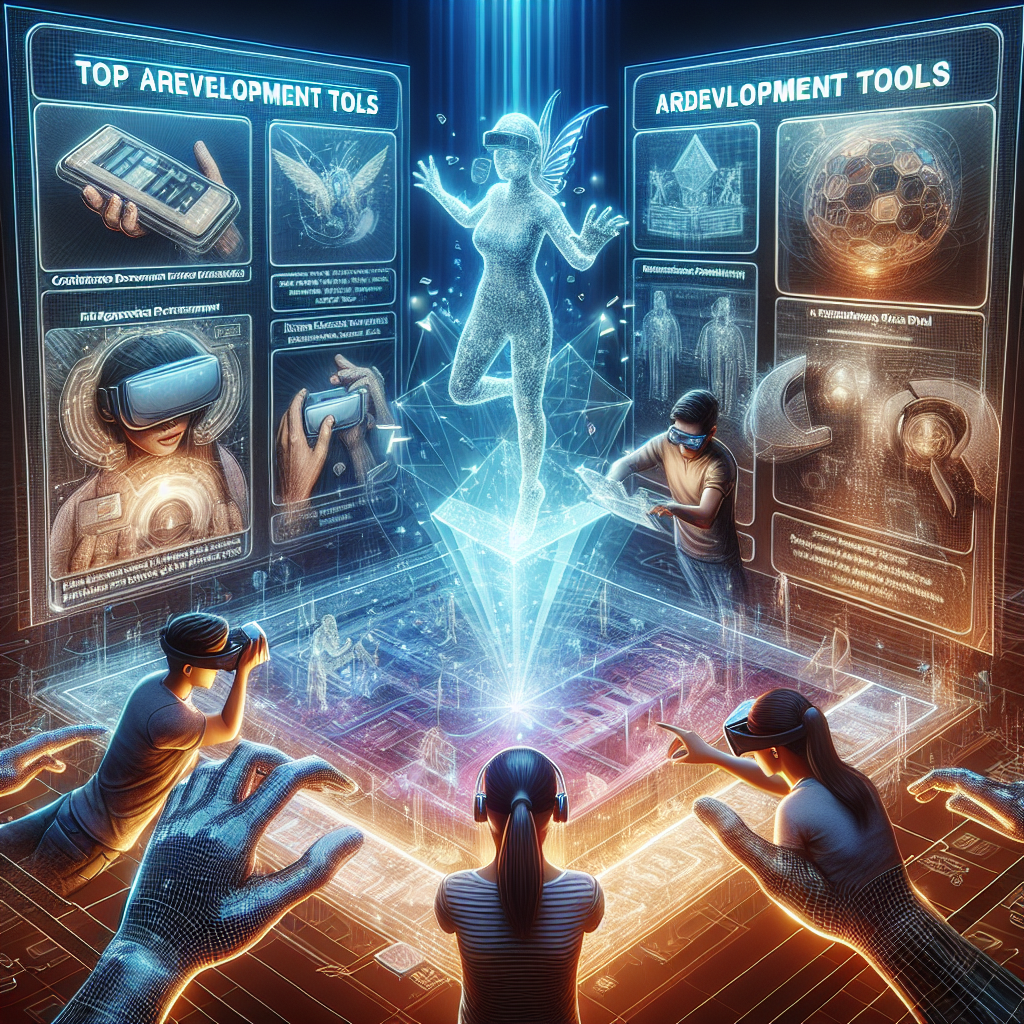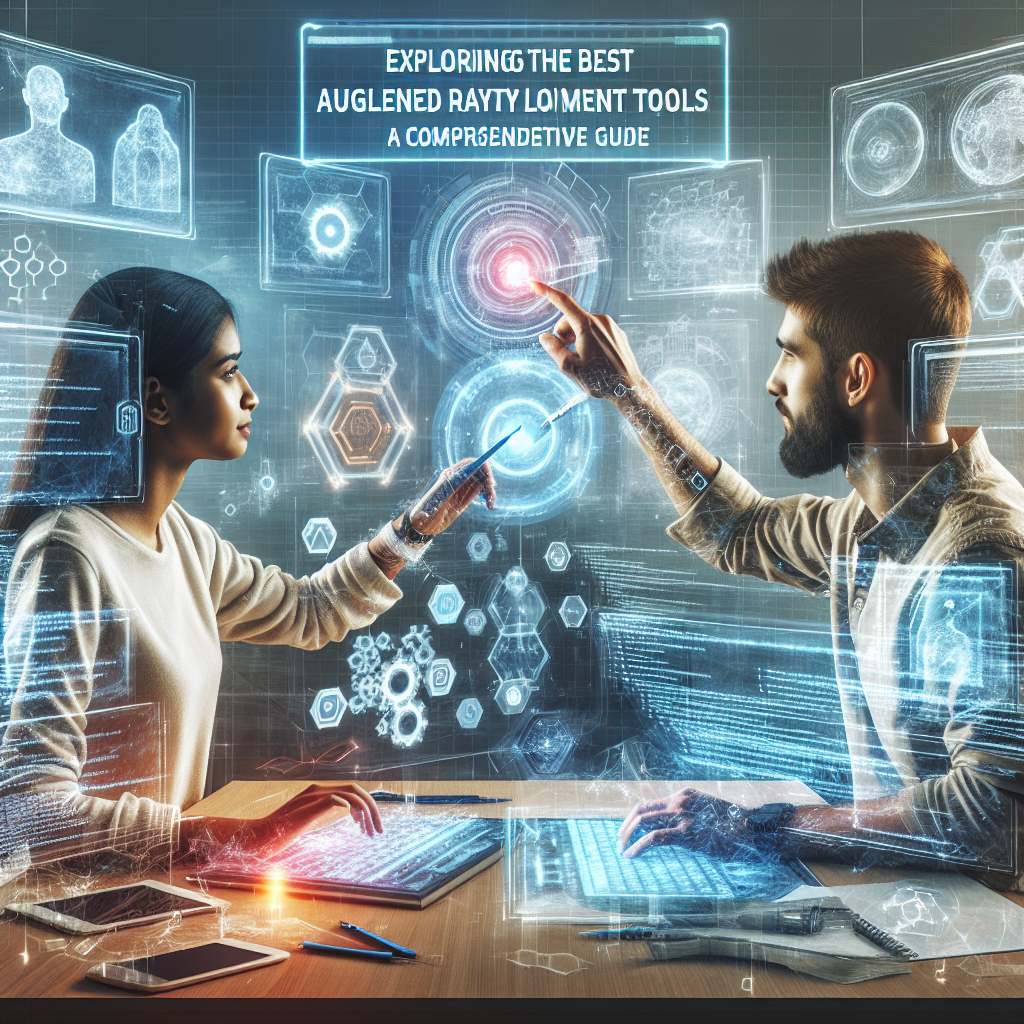Augmented reality development tools have revolutionized the way we interact with technology, merging the digital world through high speed internet with the physical environment to create immersive and interactive experiences. From creating captivating AR games to enhancing educational content, these tools have immense potential for innovation. In this comprehensive guide, we will explore the best augmented reality development tools available in the market. Whether you are a seasoned developer or a beginner looking to delve into the world of AR, this guide will provide you with valuable insights and resources to help bring your ideas to life. Join us on this exciting journey of discovery and creativity in the realm of augmented reality development.
Understanding Augmented Reality Development Tools

Augmented Reality (AR) development tools are software solutions specifically designed to facilitate the creation, deployment, and management of AR applications. These tools play a crucial role in enabling developers to integrate digital information and virtual objects into the real world seamlessly.
Definition of Augmented Reality (AR) Development Tools
Augmented Reality development tools encompass a diverse range of software applications and platforms that empower developers to build immersive AR experiences. These tools provide functionalities such as 3D modeling, scene tracking, object recognition, and interaction design to bring virtual elements into the physical environment.
Importance of Using Specialized Tools for AR Projects
Utilizing specialized AR development tools is essential for ensuring the success of AR projects. These tools offer advanced features and capabilities tailored to the unique requirements of augmented reality applications, allowing developers to create high-quality and engaging experiences for users. By leveraging specialized tools, developers can streamline the development process, optimize performance, and deliver innovative AR solutions that push the boundaries of technology.
Overview of the Role of AR Development Tools in Creating Immersive Experiences
AR development tools play a pivotal role in the creation of immersive experiences by providing developers with the necessary resources to design, build, and deploy AR applications effectively. These tools enable developers to incorporate interactive elements, realistic visuals, spatial audio, and gesture recognition into AR experiences, enhancing user engagement and immersion. By leveraging AR development tools, developers can unlock the full potential of augmented reality technology and deliver captivating experiences that blur the lines between the virtual and physical worlds.
Key Features to Look for in Augmented Reality Development Tools
Functionality
Key Features to Look for in Augmented Reality Development Tools
When considering augmented reality development tools, one of the primary aspects to evaluate is their functionality. This pertains to the tool’s ability to perform necessary tasks effectively and efficiently. Below are crucial elements to assess in terms of functionality:
- Real-time tracking capabilities:
Augmented reality development tools should offer robust real-time tracking capabilities to ensure accurate overlay of virtual elements onto the real-world environment. This feature is essential for maintaining synchronization between digital content and physical surroundings as users interact with the AR application. Tools that provide precise tracking mechanisms enhance the overall user experience by seamlessly integrating virtual elements into the real world. - 3D object recognition:
Another critical functionality to look for in AR development tools is 3D object recognition. This capability enables the AR application to identify and interact with three-dimensional objects in the physical environment. Tools with advanced 3D object recognition technology can accurately detect objects, analyze their spatial characteristics, and overlay virtual content onto them. This feature is particularly valuable for creating immersive AR experiences that respond intelligently to real-world objects, enhancing user engagement and interaction. - Interaction design options:
The availability of diverse interaction design options is a key aspect of functionality in augmented reality development tools. These tools should offer a range of interactive features and controls that allow developers to design intuitive user interfaces and engaging user experiences. Interaction design options may include gesture recognition, touch input, voice commands, and spatial interactions, among others. By providing developers with versatile interaction design capabilities, AR development tools empower them to create compelling AR applications that are user-friendly and responsive to user actions.
Compatibility
- Platform Support
- Augmented reality development tools should offer compatibility with various operating systems such as iOS, Android, and potentially other platforms to ensure a wide reach for the AR applications developed.
- Developers should look for tools that provide seamless integration and optimization for different platforms to guarantee a consistent AR experience across devices.
- Integration with Popular AR Frameworks
- It is essential for AR development tools to integrate smoothly with well-established AR frameworks like ARKit for iOS and ARCore for Android.
- Compatibility with these frameworks allows developers to leverage the advanced features and functionalities they offer, enhancing the overall quality and performance of the AR applications.
By prioritizing compatibility, developers can ensure that their augmented reality projects are accessible to a broader audience and deliver a cohesive user experience across various devices and platforms.
Top Augmented Reality Development Tools in the Market
Unity
Unity is a widely used augmented reality development tool that offers a range of features and capabilities for creating AR experiences.
Features and Capabilities
– Unity provides a comprehensive development environment with support for 2D, 3D, and augmented reality projects.
– It offers a user-friendly interface and a robust set of tools for creating interactive AR content.
– Unity supports cross-platform development, allowing developers to build AR applications for multiple devices and operating systems.
– The platform includes built-in support for popular AR frameworks such as ARCore and ARKit, simplifying the integration of AR functionality into projects.
Pros and Cons
– Pros
– Unity has a large and active community of developers, making it easy to find resources and support.
– The platform offers extensive documentation and tutorials, making it accessible to developers of all skill levels.
– Unity’s asset store provides a wide range of pre-built assets and plugins that can streamline development workflows.
– Cons
– Unity can be resource-intensive, requiring powerful hardware to run smoothly.
– Some advanced features may require additional plugins or purchases, adding to the overall cost of development.
Use Cases and Examples
– Unity is often used to create AR games, interactive marketing experiences, and educational applications.
– Popular AR apps like Pokemon GO and IKEA Place have been developed using Unity, showcasing its versatility and capabilities in the AR space.
Vuforia
Vuforia stands out as a prominent augmented reality development tool in the market due to its robust features and user-friendly interface. It provides developers with a comprehensive set of tools to create immersive AR experiences efficiently.
Overview of Vuforia as an AR Development Tool:
– Vuforia offers a wide range of functionalities, including image recognition, 3D object recognition, and environment tracking, making it suitable for various AR applications.
– Developers can leverage Vuforia’s cross-platform support, enabling them to create AR experiences for both iOS and Android devices seamlessly.
Key Features and Benefits:
– Vuforia’s advanced computer vision technology allows for precise tracking of objects and environments, enhancing the realism of AR applications.
– The tool provides access to a vast library of digital assets and templates, streamlining the development process and reducing time-to-market for AR projects.
– With Vuforia, developers can easily integrate interactive elements such as animations, videos, and 3D models into their AR experiences, fostering user engagement.
Comparison with Other Tools:
– Compared to other AR development tools, Vuforia stands out for its extensive support for a wide range of devices and platforms, making it a versatile choice for developers.
– The robust tracking capabilities of Vuforia set it apart from competitors, ensuring stable and reliable AR experiences across different environments.
– While some tools may offer specialized features, Vuforia’s comprehensive suite of tools makes it a preferred choice for developers looking to create diverse and engaging AR applications.
ARKit
- Apple’s ARKit for iOS development
ARKit is a powerful augmented reality framework developed by Apple specifically for iOS devices. It provides developers with tools and resources to create immersive AR experiences for iPhone and iPad users. ARKit leverages the device’s camera, motion sensors, and processing power to overlay digital content onto the real world seamlessly.
- Advantages and limitations
ARKit offers several advantages for developers, including high-performance tracking, accurate scene understanding, and support for features like plane detection and light estimation. Its integration with Apple’s hardware and software ecosystem ensures smooth AR experiences for users. However, ARKit’s limitations include compatibility restrictions with non-Apple devices and a learning curve for developers unfamiliar with iOS development.
- Compatibility with different Apple devices
ARKit is compatible with a wide range of Apple devices, including iPhones and iPads running iOS 11 and later. This broad compatibility allows developers to reach a large user base and create AR apps that can leverage the specific capabilities of each device. By optimizing AR experiences for different screen sizes and hardware specifications, developers can ensure a consistent and immersive experience across various Apple devices.
Comparison of Augmented Reality Development Tools
Pricing Models
When considering augmented reality development tools, one of the key aspects to evaluate is the pricing model. Understanding the different options available can help developers make informed decisions based on their budget and project requirements.
Free vs. Paid Tools
- Free Tools:
- Some AR development tools offer free versions with limited features, making them suitable for smaller projects or for developers looking to explore AR technology without a financial commitment.
- While free tools can be a cost-effective option, it’s essential to consider the restrictions they may impose, such as watermarks on content or limited access to advanced features.
- Paid Tools:
- Paid AR development tools typically offer more robust features and capabilities, making them suitable for complex projects or commercial applications.
- Developers opting for paid tools should evaluate the pricing structure, considering factors like licensing fees, additional costs for updates or support, and any recurring expenses.
Subscription-based vs. One-time Purchase
- Subscription-based:
- Many AR development tools follow a subscription-based model, where users pay a recurring fee for access to the software and ongoing updates.
- Subscriptions can provide continuous access to the latest features and support, but developers should factor in the long-term costs associated with these tools.
- One-time Purchase:
- Some AR development tools offer a one-time purchase option, allowing developers to make a single payment for perpetual access to the software.
- While upfront costs may be higher for one-time purchases, they can be more cost-effective in the long run for developers who don’t require frequent updates or additional features.
By carefully considering the pricing models of augmented reality development tools, developers can choose the option that best aligns with their project goals and budget constraints.
Ease of Use
Comparison of Augmented Reality Development Tools
When evaluating augmented reality development tools, one crucial aspect to consider is their ease of use. This factor encompasses various elements that can significantly impact a developer’s experience and efficiency in creating AR applications.
- User-friendly interfaces: The intuitiveness of the tool’s interface plays a vital role in how quickly developers can familiarize themselves with the software. Tools that feature well-organized menus, clear navigation options, and visual cues can streamline the development process and reduce the learning curve for users.
- Learning curves for developers: Another key consideration is the complexity of the tool and the amount of time it takes for developers to grasp its functionalities. Some AR development tools offer extensive documentation, tutorials, and community support, which can help developers overcome challenges and learn the tool more efficiently. Conversely, tools with steep learning curves may deter developers and hinder their ability to leverage the full potential of the software.
In conclusion, the ease of use of augmented reality development tools is a critical factor that can impact the overall development workflow and the success of AR projects. By opting for tools with user-friendly interfaces and manageable learning curves, developers can enhance their productivity and creativity in building immersive AR experiences.
Community Support
- Availability of tutorials and documentation
One crucial aspect to consider when evaluating augmented reality development tools is the availability and comprehensiveness of tutorials and documentation provided by the tool’s community. Robust community support often translates to a wealth of resources that can aid developers in understanding and utilizing the tool to its full potential. Tools with extensive documentation that includes detailed guides, API references, and code samples can significantly expedite the learning curve for developers, enabling them to quickly grasp the tool’s functionalities and best practices.
- Online forums and communities for troubleshooting
In addition to documentation, the presence of active online forums and communities dedicated to a particular AR development tool is invaluable. These forums serve as platforms where developers can seek assistance, share insights, and troubleshoot issues they encounter while working with the tool. Engaging with a vibrant community can provide developers with real-time support, enabling them to resolve technical challenges more efficiently. Furthermore, community forums often foster collaboration and knowledge-sharing, allowing developers to stay updated on the latest trends, techniques, and updates related to the AR tool they are using.

Best Practices for Choosing Augmented Reality Development Tools
When embarking on an augmented reality (AR) development project, selecting the right tools is essential for success. To ensure a seamless development process and optimal outcomes, consider the following best practices when choosing AR development tools:
- Consider project requirements and scope:
- Before selecting an AR development tool, carefully assess the specific requirements and scope of your project. Different tools offer varying features and capabilities, so aligning these with your project needs is crucial. For instance, if your project involves complex 3D models and interactions, you may require a tool with robust rendering capabilities and advanced tracking algorithms. On the other hand, for simpler AR applications, a more user-friendly and lightweight tool might be sufficient.
- Evaluate tool compatibility with existing technologies:
- Compatibility with existing technologies is another key factor to consider when choosing AR development tools. Ensure that the tool seamlessly integrates with your current software stack, hardware devices, and any third-party services or platforms you plan to use. This compatibility can streamline the development process, facilitate data sharing across systems, and prevent potential technical issues down the line. Additionally, consider the scalability of the tool and its ability to adapt to future technological advancements.
- Seek feedback from experienced AR developers:

- Drawing insights from experienced AR developers can provide valuable guidance in selecting the most suitable development tools. Reach out to industry professionals, participate in AR developer communities, or attend workshops and conferences to gather recommendations and best practices. By leveraging the knowledge and experiences of seasoned developers, you can gain valuable insights into the strengths and limitations of different tools, as well as emerging trends in the AR development landscape. This feedback can help you make informed decisions and avoid common pitfalls during the tool selection process.
Future Trends in Augmented Reality Development Tools
In the realm of augmented reality development tools, the future holds exciting advancements that are set to revolutionize the way AR experiences are created and implemented. Here are some key trends to watch out for:
- Integration of Machine Learning and AI Capabilities
- The integration of machine learning and artificial intelligence capabilities into AR development tools is poised to enhance the overall user experience by enabling more personalized and interactive AR content.
- Machine learning algorithms can analyze user behavior and preferences to deliver tailored AR experiences, while AI-powered features can enable real-time object recognition and tracking in AR applications.
- Advancements in AR Authoring Tools
- Future AR authoring tools are expected to become more user-friendly and intuitive, allowing developers to create AR content more efficiently and with greater creative freedom.
- These advancements may include drag-and-drop interfaces, pre-built templates, and enhanced visual scripting capabilities that simplify the AR development process for both experienced and novice developers.
- Impact of AR Cloud Technology on Development Processes
- The emergence of AR cloud technology is set to revolutionize how AR experiences are delivered and experienced, as it enables persistent and shared AR content that can be accessed across multiple devices and locations.
- AR cloud technology will streamline development processes by providing developers with access to a centralized repository of spatial data, reducing the need to create and store large AR assets locally on users’ devices.
FAQs for Exploring the Best Augmented Reality Development Tools: A Comprehensive Guide
What are some popular augmented reality development tools currently available in the market?
Some popular augmented reality development tools currently available in the market include Unity 3D, ARKit, ARCore, Vuforia, Wikitude, and Spark AR Studio. These tools provide a range of features and functionalities to help developers create immersive AR experiences for various platforms.
How do these augmented reality development tools differ from each other?
Each augmented reality development tool has its own set of features, capabilities, and compatibility with different platforms. For example, Unity 3D is known for its versatility and ability to create high-quality graphics, while ARKit and ARCore are specifically designed for iOS and Android devices, respectively. Vuforia offers easy integration with popular game engines like Unity and Unreal Engine, while Spark AR Studio is geared towards creating AR experiences for Facebook and Instagram.
What are some key factors to consider when choosing an augmented reality development tool?
When choosing an augmented reality development tool, it is important to consider factors such as platform compatibility, ease of use, cost, community support, and the specific features required for the project. Developers should also assess the scalability and performance of the tool to ensure that it meets their project requirements and can handle the complexities of augmented reality development.
Are there any free augmented reality development tools available for developers?
Yes, there are free augmented reality development tools available for developers, such as ARKit, ARCore, and Spark AR Studio. These tools offer basic functionalities and features for creating AR experiences without any additional cost. However, developers may need to upgrade to a paid version or purchase additional plugins for more advanced capabilities and customization options.